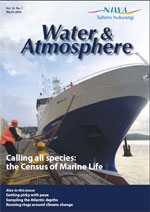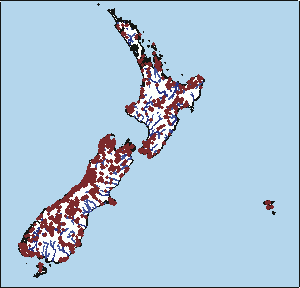PDF of this article (90 KB)

Letting it rip at Raglan

In January, scientists from NIWA joined forces with Surf Life Saving New Zealand to investigate the behaviour of rips. For the experiment they ‘placed’ a surf lifeguard in a rip and followed his trajectory as he was carried offshore. The scientists onshore charted his speed and position using a GPS satellite tracking device attached to his helmet and NIWA’s Cam-Era video beach-monitoring system. The lifeguard was repeatedly placed in rips to see how fast he travelled in different tide and wave conditions. To ensure his safety during the experiment, he wore a wetsuit and helmet, and carried a ‘rescue tube’ for flotation. He was also followed by a fully equipped safety boat and closely watched by surf lifeguards in the Raglan Surf Life saving Patrol, who were in radio contact with the safety boat.
We’ll use the data from the experiment to calibrate models of how rips form and behave and, ultimately, to assist surf lifeguards in rescuing people and recovering bodies caught in rips. In the long-run, the information will also be used to predict the likelihood of rips developing, which will be incorporated into a beach hazard rating for all New Zealand beaches that Surf Life Saving New Zealand is developing with help from NIWA.
The research is funded by the Foundation for Research, Science & Technology.
For further information, contact: Dr Giovanni Coco, 0-7-856 1701, [email protected] More about Cam-Era: www.niwa.co.nz/services/free/cam-era
State of the Environment reporting made easy
Time Trends, new data-analysis software from NIWA, made its debut at the joint conference of the New Zealand Freshwater Sciences Society and the Australian Limnological Society in Queenstown in December. The new software provides a robust yet simple-to-use tool for analysing water quality data, with a particular emphasis on State of the Environment (SoE) reporting. Time Trends will save regional councils significant time and resources in SoE analysis and reporting.
For example, ARC contracted NIWA in 2007 to analyse freshwater quality state and trends in the region. The new software more than halved the cost of the projectcompared to the last assesssment in 2000. By reducing reporting time and costs, Time Trends can increase the frequency with which regional councils are able to report on the state of the environment and reduce the responsetime for management action on emerging environmental issues.
The development of Time Trends was co-funded by Envirolink and NIWA’s FRST programme ‘Effects-based Protection and Management of Aquatic Ecosystems’.
Time Trends is available through the National Centre for Water Resources: www.niwascience.co.nz/ncwr
New ocean profiler for NIWA

Though it is well understood that theoceans are stratified (layered), and that mixing of the layers controls processes relevant to climate and ecosystems, the details behind this mixing are less well known. Depending on circumstances, mixing might be driven by the obvious (such as storms or flow past headlands), the regular but hidden (large internal tide waves), or the very subtle (ocean ‘spice’, where differences in the diffusive properties of heat and salt lead to layering and mixing).
One approach is to consider the largest scales of variability and try and back-calculate the mixing that was required forthis to happen. The converse approach is to seek out the events (sometimes only a metre in scale) that drove the very genesis of the mixing. To do this we use a ‘microstructure profiler’ – a torpedo-like device covered in tiny needle-like sensors; as it falls through the water, the sensors measure the very smallest scales of turbulence in the water column.
NIWA scientists have used a number of profilers over the last decade and we’ve just upgraded to a stateof-the-art VMP-500 from Rockland Oceanographic Services in Canada. In January, Brett Grant and Craig Stevens travelled to Victoria, British Columbia, to commission the new profiler and receive some valuable training in how to use the highly sensitive instrument. When it arrived in February, it was immediately pressed into service in experiments looking at mixing in the Marlboough Sounds. Future plans include work in Cook Strait and McMurdo Sound.
For further information, contact: Dr Craig Stevens, 0-4-386 0476, [email protected]
